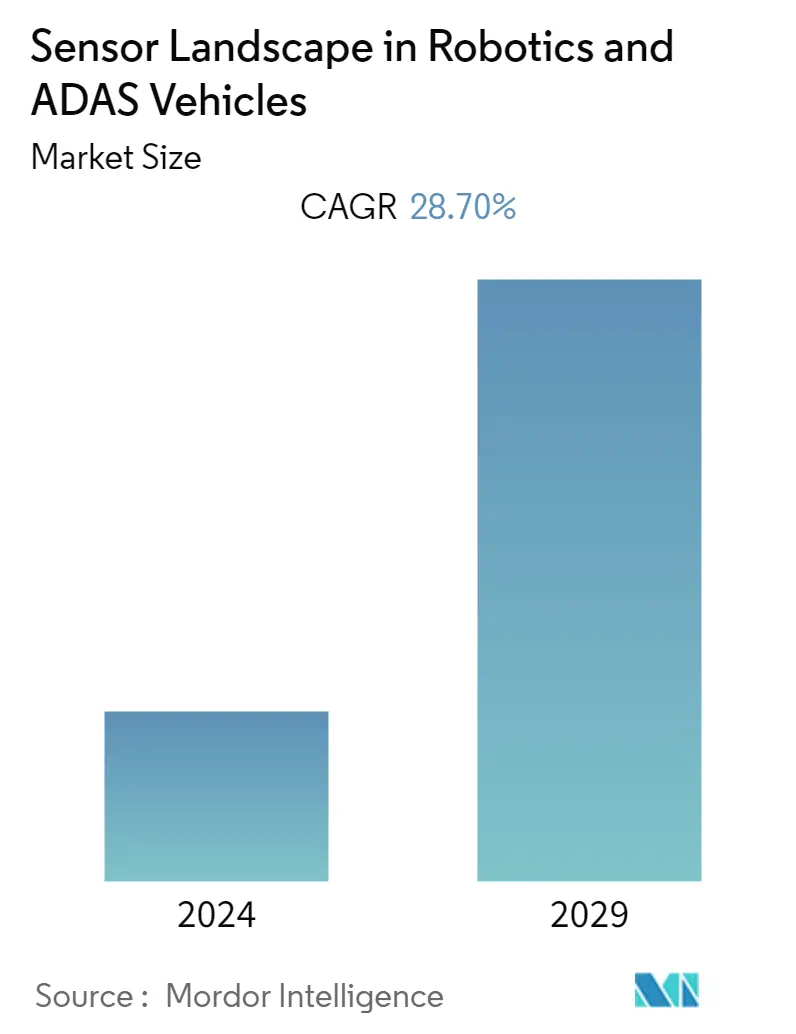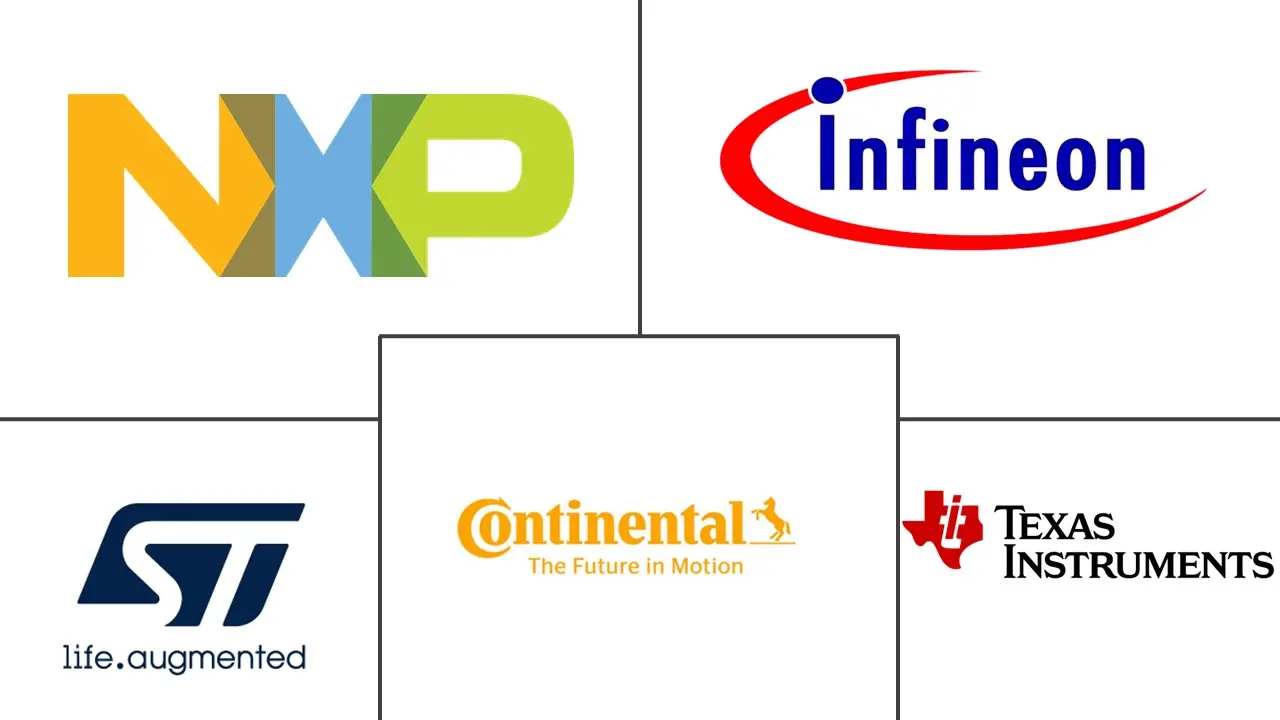Market Size of Sensor Landscape in Robotics and ADAS Vehicles

| Study Period | 2019 - 2029 |
| Base Year For Estimation | 2023 |
| CAGR | 28.70 % |
| Fastest Growing Market | Asia Pacific |
| Largest Market | North America |
| Market Concentration | Low |
Major Players
*Disclaimer: Major Players sorted in no particular order |
Sensor Landscape in Robotics and ADAS Vehicles Market Analysis
The sensor landscape in robotic and ADAS vehicles is expected to reach a CAGR of 28.7% during the forecast period (2020 - 2025). An increasing adoption rate of ADAS and AD will be responsible for an overall expected growth rate of 8 percent in automotive sensors. The global market for advanced driver assistance systems, known in the industry as ADAS, is expected to reach more than $67 billion by 2025, growing more than 10 percent each year.
- Also, the increasing research and development activities to roll out fully autonomous cars require sensing technologies that are of great importance to enable 360-degree safety around the vehicle. Companies such as Google and Uber are already working on fully automated robotic cars.
- The Radar Sensor market has never been so dynamic, this market period of rapid technological innovation. New opportunities for radar are still emerging with, for instance, vital-sign driver monitoring systems, chassis-to-ground monitoring, and hands-free trunk opening. The industry is now envisioning radar imaging as a possibility. There's no doubt this technology will be critical in autonomous and robotic cars, ad aviation. For instance, in 2019, Velodyne launched Alphapuck at the Symposium event in Orlando. It is a lidar sensor specifically made for autonomous driving and advanced vehicle safety at highway speeds. It delivers a combination of long-range high resolution and wide field of view.
- Government mandates to install technology such as collision avoiding automatic brake systems are driving the market. Similarly, the emphasis of government to lower vehicle emissions will need cars and other commercial vehicles to be more fuel-efficient, resulting in the growth of pressure sensors. The Chinese government, for example, will introduce the new "6A" emission standard by 2020 to further lower vehicle emissions.
- With the recent outbreak of COVID 19, the Automotive sensor is witnessing a decline in growth due to major automotive manufacturing plants that have entirely stopped their production in response to lockdown being enforced by many countries across the world. Moreover, the self-driving vehicle has taken a hit, and the arrival of autonomous driving tech will be slowed, probably one to two years, because of the recent drastic downturn in auto sales and production due to COVID-19. For instance, Ford delayed its autonomous vehicle production until 2022 to rethink its strategy after the COVID-19 impact.
Sensor Landscape in Robotics and ADAS Vehicles Industry Segmentation
Sensor Landscape in robotic and ADAS vehicles is growing at a fast pace owing to rising awareness on worker safety & stringent regulations and steady increase in the industrial sector in key emerging countries in Asia-Pacific, coupled with expansion projects. The market is segmented based on the type of sensors and geography.
| Type | |
| LiDAR (Robotic Vehicles Vs. ADAS Vehicles) | |
| Radar (Robotics Vehicles Vs. ADAS Vehicles) | |
| Camera Modules (Robotics Vehicles Vs. ADAS Vehicles) | |
| GNSS (Robotic Vehicles) | |
| Inertial Measurement Units (Robotic Vehicles) |
| Geography | |
| North America | |
| Europe | |
| Asia Pacific | |
| Latin America | |
| Middle East and Africa |
Sensor Landscape in Robotics and ADAS Vehicles Size Summary
The sensor landscape in robotics and Advanced Driver Assistance Systems (ADAS) vehicles is experiencing significant growth, driven by the increasing adoption of these technologies in the automotive industry. The market is characterized by rapid technological advancements and the emergence of new opportunities, particularly in radar and lidar sensor applications. Companies like Google and Uber are at the forefront of developing fully autonomous vehicles, necessitating advanced sensing technologies for enhanced safety and functionality. Government mandates for safety features, such as collision-avoidance systems, are further propelling the market. However, the COVID-19 pandemic has posed challenges, causing delays in autonomous vehicle production and impacting sensor market growth due to halted automotive manufacturing.
The North American region is a leader in adopting ADAS-enabled vehicles, with major players like Google, Uber, and Tesla integrating various sensing technologies to improve vehicle safety and efficiency. The market is fragmented, with key players such as Infineon Technologies AG, Continental AG, and Texas Instruments Incorporated driving innovation and expanding their presence through strategic investments and partnerships. Despite the promising growth prospects, challenges such as high initial costs of radar sensors and geopolitical tensions, like the trade war between the USA and China, could impact market dynamics. Nonetheless, the ongoing technological transition in the automotive industry, focusing on safety, comfort, and entertainment, continues to create opportunities for sensor market expansion.
Sensor Landscape in Robotics and ADAS Vehicles Market Size - Table of Contents
-
1. MARKET DYNAMICS
-
1.1 Market Overview
-
1.2 Industry Value Chain Analysis
-
1.3 Industry Attractiveness - Porter's Five Forces Analysis
-
1.3.1 Bargaining Power of Suppliers
-
1.3.2 Bargaining Power of Consumers
-
1.3.3 Threat of New Entrants
-
1.3.4 Threat of Substitutes
-
1.3.5 Intensity of Competitive Rivalry
-
-
1.4 Market Drivers
-
1.4.1 Rising awareness on worker safety & stringent regulations
-
1.4.2 Steady increase in industrial sector in key emerging countries in Asia-Pacific, coupled with expansion projects
-
-
1.5 Market Challenges
-
1.5.1 Recent outbreak of COVID-19 and marginal decline in spending in key verticals expected to pose a concern to manufacturers
-
-
1.6 Light Passenger Car and Robotic Vehicle Sales Statistics by Level of Autonomy ?
-
1.7 Key Industry Standards & Regulations
-
1.8 Technological Roadmap for Automotive Sensors (Radar, Camera & LiDAR)
-
1.9 Assessment of Impact of Covid-19 on the Industry
-
-
2. MARKET SEGMENTATION
-
2.1 Type
-
2.1.1 LiDAR (Robotic Vehicles Vs. ADAS Vehicles)
-
2.1.2 Radar (Robotics Vehicles Vs. ADAS Vehicles)
-
2.1.3 Camera Modules (Robotics Vehicles Vs. ADAS Vehicles)
-
2.1.4 GNSS (Robotic Vehicles)
-
2.1.5 Inertial Measurement Units (Robotic Vehicles)
-
-
2.2 Geography
-
2.2.1 North America
-
2.2.2 Europe
-
2.2.3 Asia Pacific
-
2.2.4 Latin America
-
2.2.5 Middle East and Africa
-
-
Sensor Landscape in Robotics and ADAS Vehicles Market Size FAQs
What is the current Sensor Landscape in Robotics and ADAS Vehicles Market size?
The Sensor Landscape in Robotics and ADAS Vehicles Market is projected to register a CAGR of 28.70% during the forecast period (2024-2029)
Who are the key players in Sensor Landscape in Robotics and ADAS Vehicles Market?
Infineon Technologies AG, NXP Semiconductor N.V., Continental AG, ST Microelectronics NV and Texas Instruments Incorporated are the major companies operating in the Sensor Landscape in Robotics and ADAS Vehicles Market.

